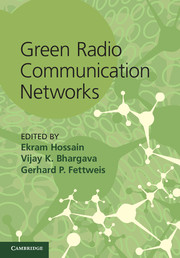Book contents
- Frontmatter
- Contents
- List of contributors
- Preface
- Part I Communication architectures and models for green radio networks
- Part II Physical communications techniques for green radio networks
- Part III Base station power-management techniques for green radio networks
- 8 Opportunistic spectrum and load management for green radio networks
- 9 Energy-saving techniques in cellular wireless base stations
- 10 Power management for base stations in a smart grid environment
- 11 Cooperative multicell processing techniques for energy-efficient cellular wireless communications
- Part IV Wireless access techniques for green radio networks
- Part V Green radio test-bed, experimental results, and standardization activities
- Index
- References
8 - Opportunistic spectrum and load management for green radio networks
from Part III - Base station power-management techniques for green radio networks
Published online by Cambridge University Press: 05 August 2012
- Frontmatter
- Contents
- List of contributors
- Preface
- Part I Communication architectures and models for green radio networks
- Part II Physical communications techniques for green radio networks
- Part III Base station power-management techniques for green radio networks
- 8 Opportunistic spectrum and load management for green radio networks
- 9 Energy-saving techniques in cellular wireless base stations
- 10 Power management for base stations in a smart grid environment
- 11 Cooperative multicell processing techniques for energy-efficient cellular wireless communications
- Part IV Wireless access techniques for green radio networks
- Part V Green radio test-bed, experimental results, and standardization activities
- Index
- References
Summary
Introduction
Historically, the radio spectrum has been managed in a rather rigid fashion where systems have been constrained to very specific bands in order to avoid interference and maintain the spectrum's viability. This regime is extremely inefficient, because at any one time many systems are not being used thereby leaving their associated spectrum also unused. Alternative spectrum management, where systems not designated for a particular band may nevertheless use it if it is available, would greatly increase spectrumusage efficiency and capacity.
Communications traffic has also historically been managed in a somewhat inefficient manner, whereby traffic load has usually only been carried on a specific band as directed by the “owner” of the user/device carrying the traffic. Improved traffic-load management techniques, where the traffic can be shared among bands and systems, would also increase efficiency or capacity. Although the end-user may sometimes have a limited choice of which band to receive traffic on (e.g. via a Wi-Fi interface using an ISM/UNII band, or via a 3G mobile communications interface using a UMTS band), centralized control of that choice, in a timely fashion, can far better manage efficiency and capacity than the end-user operating alone.
Such opportunistic load and spectrum management between bands/systems is being made feasible by operators having an increasingly wide range of spectrum bands at their disposal, of very different frequencies and physical characteristics. Operators may typically operate a range of different systems on this range of spectrum bands.
Information
- Type
- Chapter
- Information
- Green Radio Communication Networks , pp. 167 - 189Publisher: Cambridge University PressPrint publication year: 2012
References
Accessibility standard: Unknown
Why this information is here
This section outlines the accessibility features of this content - including support for screen readers, full keyboard navigation and high-contrast display options. This may not be relevant for you.Accessibility Information
- 1
- Cited by
